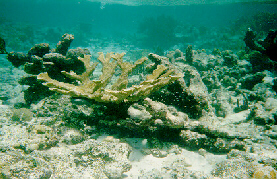CORAL REEFS
Coral reefs are unlike any other sedimentary deposits. They are not simply products of physical sedimentation, but are structures built by a community of organisms growing in one place for an extended period of time. They result from biological accretion, chemical and biochemical carbonate precipitation, biological and physical erosion, and physical deposition, all acting together. Thus to study and appreciate reefs one must think not like a specialist but like a natural scientist bringing together aspects of stratigraphy, paleontology, sedimentology, geochemistry, and petrology to fathom the nature of these fascinating things.
Fossil reefs are storehouses of paleontological information and modern reefs are natural laboratories for the study of benthic marine ecology. Fossil reefs contain an unusually sensitive and legible record of earth history and the evolution of life. Because organisms have changed with time, it is difficult, at first glance, to compare modern and specific ancient reefs. For instance, a reef at any one time may be quite different from a reef only a few million rears younger or older. Carbonate secreting organisms in the rock record however when viewed as sediment producers, have equivalents in modern oceans, although they may not even the same phyla. Thus geologists rely heavily upon observations in modern reef environments of deposition to interpret ancient reefal sedimentary sequences and construct facies models.
 Coral reefs are of enormous importance to the marine environment; as complex climax communities, as sites of food production, and as nurseries for many creatures. Therefore, their preservation and encouragement are important to both the general condition of the oceans and to the well being of coastal people.
Coral reefs are of enormous importance to the marine environment; as complex climax communities, as sites of food production, and as nurseries for many creatures. Therefore, their preservation and encouragement are important to both the general condition of the oceans and to the well being of coastal people.
The necessity to understand coral reefs is far from solely an academic pursuit. In the modern seas these structures not only act as a living barrier, protecting heavily inhabited shorelines, but are also important sources of tourist income in many countries. Fossil reefs buried in the subsurface contain a disproportionally large amount of our hydrocarbon resources compared to other types of sedimentary deposits; probably more than a third of the world's reserves and an important share of certain metallic ores. This fact alone has resulted in reefs being studied in more detail by paleontologists and sedimentologists than perhaps any other type of sedimentary deposit. Of historical interest, coral reefs were strategically important in the Pacific Ocean during the Second World War and even more unfortunately, they were the sites of nuclear tests from the late 40's to the 60's and also more recently with the highly contested French nuclear tests.
